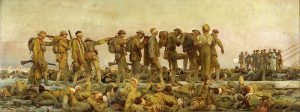The highly acclaimed American artist John Singer Sargent (1856-1925), who spent most of his life in Europe, is chiefly remembered as a gifted society portrait painter. Returning to England from the United States in 1918, the British Ministry of Information commissioned him as a war artist to document the Great War for the British War Memorials Committee. Sargent visited the Western Front in France in 1918, ‘embedded’ with a British division near Arras and later with the American Expeditionary Forces near Ypres.
His best-known piece is the meticulously researched, large landscape painting of a scene in the trenches, ‘Gassed’ (1919 – now at the Imperial War Museum, London), which depicts the harrowing aftermath of a mustard gas attack: a line of wounded soldiers, blinded by the gas, is assisted by two medical orderlies as they painstakingly make their way to a dressing-station. Fellow artist, Henry Tonks, later described the scene:
‘The dressing station… consisted of a number of huts and a few tents. Gassed cases kept coming in, led along in parties of about six just as Sargent has depicted them, by an orderly. They sat or lay down on the grass, there must have been several hundred, evidently suffering a great deal, chiefly I fancy from their eyes which were covered up by a piece of lint… Sargent was very struck by the scene and immediately made a lot of notes. It was a very fine evening and the sun toward setting.’ (1)
The painting is a powerful testimony to the devastating effects of the early use of chemical weapons, which would later be banned worldwide.
References/Further Reading:
(1) Letter to Alfred Yockney, 19 Mar 1920, cited Imperial War Museums: Gassed.
Wikipedia. Gassed (painting).


